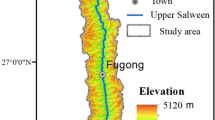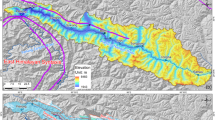Abstract
Hengduan mountainous area in southwestern China is highly susceptible to debris flow hazards. In order to investigate the spatial distribution of 7181 debris-flow-prone catchments, the area has been classified into six natural geographical sub-regions based on its climatic, geological, and geomorphic types. The spatial analysis reveals that their spatial distribution exhibits a significant difference in the six sub-regions. The sub-regions with East Asian monsoon climate have a higher density of catchments than other sub-regions with Tibetan cold climate. The highest density is 286 catchments per 10,000 km2, seven times the lowest sub-region. The DFCs are clustered in Dadu River basin, Minjiang River basin, Yalong River basin, Jinsha River basin (Mainstream below Shigu), and Jinsha River basin (mainstream from Zhimengda to Shigu). The climatic factor is more important than the other factors. The histogram of the catchments with average annual rainfall shows that the regions with an annual rainfall of 800–1050 mm are more prone to debris flows. Relative elevation, mean slope, and landcover were chosen to examine the distribution of the debris flow catchments along with geomorphologic factors. It is found that the sub-watersheds within 3 km from faults and 5 km from the main river in 0.10 g, 0.15 g, and 0.2 g PGA class with a relative elevation of 1000–2000 m, mean slope of 15–25°, and woodland cover are the most highly susceptible to debris flows.





Similar content being viewed by others
References
Carr N, Kirstetter PE, HonY GJJ, Schwaller M, Petersen W, Wang NY, Ferraro RR, Xue XW (2015) The influence of surface and precipitation characteristics on TRMM microwave imager rainfall retrieval uncertainty. J Hydrometeorol 16:1596–1614
Cui P, Su F, Ge Y, Chen X, Zou Q (2017) Natural hazards in Tibetan plateau and key issue for feature research. Bulletin of Chinese Academy of Sciences 32(9):985–992
Ding J, Yan Y, Yue CT, Wang DW, Mao Y, Wei LW, Chang XJ, Wang J (2007) Analysis of the geological hazards’ distribution and development trend in Dadu River Catchments of Sichuan Province. The Chinese Journal of Geological Hazard and Control 18(S0):22–25 (in Chinese)
Dowling CA, Santi PM (2014) Debris flows and their toll on human life: a global analysis of debris-flow fatalities from 1950 to 2011. Nat Hazards 71(1):203–227
Guan FJ, Shen WZ (2017) Analysis of prevention and control of geological disasters and trend prediction in China. The Chinese Journal of Geological Hazard and Control 28(1):1–3
Hu K, Cui P, Wang C, Li Y, Lu X (2010) Characteristic rainfall for warning of debris flows. J Mt Sci 7(3):207–214
Huang T, Ding MT, Jiang LH, Guo HT (2019) Relative importance analysis of debris flow influence factors based on gographical detectors:a case study in the Upper Reaches of Min River. Journal of Southwest China Normal University (natural Science Edition) 44(9):45–51 (in Chinese)
Jomelli V, Pavlova I, Giacona F, Zgheib T, Ecker N (2019) Respective influence of geomorphologic and climate conditions on debris-flow occurrence in the Northern French Alps. Landslides, 2019, 16: 1871–1883
Kang S, Lee SR, Nikhil NV, Park JY (2015) Analysis of differences in geomorphological characteristics on initiation of landslides and debris flows. J Korean Soc Hazard Mitig 15:249–258
Levine N (2004) CrimeStat III: a spatial statistics program for the analysis of crime incident locations (version 3.0). Houston (TX): Ned Levine & Associates/ Washington, DC: National Institute of Justice.
Liu H, Lan HX, Liu Y, Zhou Y (2009) Characteristics of spatial distribution of debris flow and the effect of their sediment yield in main downstream of Jinsha River. China Environ Earth Sci 64(6):1653–1666
Liu S, Wei L, Hu KH (2020) Topographical and geological variation of effective rainfall for debris-flow occurrence from a large-scale perspective. Geomorphology 358:107134
Lorente A, García-Ruiz JM, Arnáez SB (2002) Factors Explaining the spatial distribution of hillslope debris flows: a case study in the Flysch sector of the Central Spanish Pyrenees. Mt Res Dev 22(1):32–39
Mandal S, Maiti R (2015) Geomorphic threshold and landslide. In: Mandal, S., Maiti, R. (Eds.), Semi-quantitative Approaches for Landslide Assessment and Prediction. Springer Singapore, Singapore. 145–166.
Wang JF, Zhang TL, Fu BJ (2016) A measure of spatial stratified heterogeneity. Ecol Ind 67:250–256
Shen Y (2019) Data set of third-order river basins in China (1:250 000) National Cryosphere Desert Data Center (www.ncdc.ac.cn). (in Chinese)
Wei L, Hu KH, Hu XD (2018) Rainfall occurrence and its relation to flood damage in China from 2000 to 2015. Journal Mountain Science 15(11):2492–2504
Winter M, Dent J, Macgregor F, Dempsey P, Motion A, Shackman L (2010) Debris flow, rainfall and climate change in Scotland. Q J Eng GeolHydrogeol 43(4):429–446
Xu C, Xu X, Bruce H (2015) Database and spatial distribution of landslides triggered by the Lushan, China Mw 6.6 earthquake of 20 April 2013. Geomorphology 248:77–92
Zhang N, Fang ZW, Han X, Chen CL, Qi XB (2018) The study on temporal and spatial distribution law and cause of debris flow disaster in China in recent years. Earth Sci Front 025(2):299–308 (in Chinese)
Zhang RZ, Zheng D, Yang QY, Liu YH. (1997) Physical geography of Hengduan Mountains. Institute of Geography, Chinese of Academic of Science, Beijing, China (in Chinese)
Zhou W, Tang C (2014) Rainfall thresholds for debris flow initiation in the Wenchuan earthquake-stricken area, southwestern China. Landslides 11(5):877–887
Funding
This work has been supported by the National Key R&D Program of China (Grant No. 2020YFD1100701), National Natural Science Foundation of China (Grant No. 41790434), and the Research on Intelligent Monitoring and Early Warning Technology of Debris Flow on Sichuan-Tibet Railway (K2019G006).
Author information
Authors and Affiliations
Corresponding author
Ethics declarations
Conflict of interest
The authors declare that they have no competing interests.
Additional information
Responsible Editor: Stefan Grab
Rights and permissions
About this article
Cite this article
Wei, L., Hu, K. & Liu, S. Spatial distribution of debris flow-prone catchments in Hengduan mountainous area in southwestern China. Arab J Geosci 14, 2650 (2021). https://doi.org/10.1007/s12517-021-08818-1
Received:
Accepted:
Published:
DOI: https://doi.org/10.1007/s12517-021-08818-1




